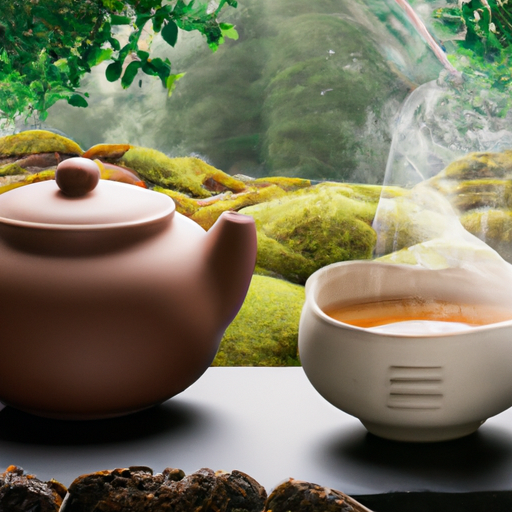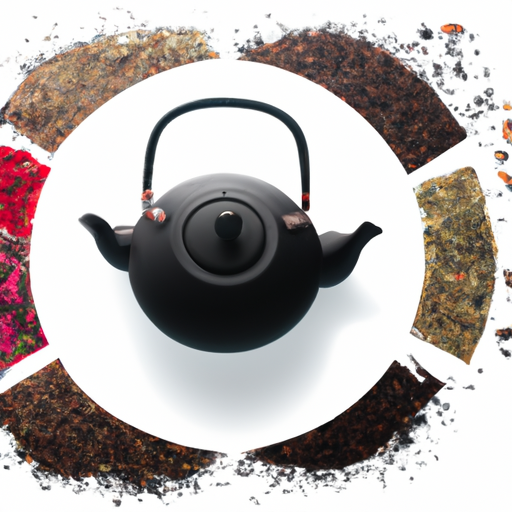Coincidentally, as I sit here sipping on my cup of tea, I can’t help but ponder the distinct differences and benefits of two of my favorite brews: Earl Grey and green tea.
Although both derived from the same Camellia Sinensis plant, these teas offer unique characteristics that cater to different palates and health needs.
Earl Grey, with its captivating citrus scent, has found favor in the western world, while green tea remains a beloved staple in China.
As I delve deeper into the realm of tea, I discover that Earl Grey can be a delightful variation of any tea type, while green tea stands as one of the main six tea varieties.
When it comes to health benefits, Earl Grey’s higher caffeine content provides an energizing kick, while green tea boasts an abundance of catechins, EGCG, and L-theanine, known for their immune-boosting and weight loss properties.
Both teas can be incorporated into baking and lattes, making them versatile options for any time of day.
However, it is crucial to consult with a healthcare professional before utilizing teas or herbs for serious medical conditions.
So, let’s embark on a journey to unravel the nuances and merits of Earl Grey and green tea, and discover how these brews can elevate our tea-drinking experience.
Key Takeaways
- Earl Grey and green tea are both made from the Camellia Sinensis plant.
- Earl Grey is more popular in western countries, while green tea is popular in China.
- Green tea has more catechins and better antioxidant activity than black tea.
- Both Earl Grey and green tea may provide an energy boost in the morning.
Types and Characteristics
I know that Earl Grey and green tea are both made from the Camellia Sinensis plant, but they have different oxidation levels. Green tea is unoxidized and black tea (such as Earl Grey) is fully oxidized.
When it comes to brewing methods, both teas can be steeped in hot water, but green tea is typically brewed at a lower temperature than Earl Grey.
Additionally, there are different types of green tea leaves. Gunpowder green tea, for example, is commonly used as a base for making Green Earl Grey. This type of green tea is tightly rolled and retains its freshness for longer periods.
The choice of green tea leaves can affect the overall flavor and aroma of Green Earl Grey. It gives it a lighter and fresher taste compared to black Earl Grey.
History and Popularity
Earl Grey, with its origins in the early 19th century, has gained popularity in Western countries while green tea has been enjoyed in China for over 1000 years. The cultural significance of these teas is evident in their global consumption patterns.
Here are three key points to consider:
-
Historical Significance: Earl Grey, named after the British Prime Minister, was created as a unique blend of black tea and bergamot essential oil. Its popularity grew rapidly among the British aristocracy and gradually spread to other Western countries. On the other hand, green tea has a rich history in Chinese culture and has been an integral part of traditional ceremonies and daily life for centuries.
-
Global Consumption: Earl Grey is extensively consumed in the Western world, particularly in countries like the United States and the United Kingdom. It has become a staple in tea shops and households, often enjoyed with milk or as a base for lattes. Green tea, on the other hand, remains highly popular in China and other Asian countries, where it is often consumed in its pure form without any additions.
-
Taste Preferences: Earl Grey offers a distinct flavor profile with a citrusy aroma from the bergamot oil. It has a robust and rich taste, often enjoyed with a touch of sweetness. Green tea, in contrast, has a more delicate and grassy flavor, with a refreshing and light quality. Its taste can vary depending on the variety and brewing method, but it is generally appreciated for its natural, earthy notes.
The cultural significance and global consumption patterns of Earl Grey and green tea highlight the diversity and appreciation for different tea traditions around the world. Whether you prefer the boldness of Earl Grey or the subtlety of green tea, both offer unique experiences that have captivated tea enthusiasts for generations.
Aroma and Flavor
When discussing the aroma and flavor of Earl Grey and green tea, it’s important to note their distinctive characteristics and sensory experiences.
Brewing techniques play a significant role in bringing out the unique flavors of each tea. Earl Grey, with its signature citrus scent from bergamot essential oil, offers a bold and robust flavor. The bergamot adds a bright and refreshing note to the black tea base, resulting in a rich and aromatic cup.
On the other hand, green tea has a fresh and vegetal flavor profile. When scented with bergamot to create Green Earl Grey, the tea takes on a lighter and more delicate taste compared to its black counterpart. The combination of the earthy green tea and the citrusy bergamot creates a harmonious and invigorating infusion.
Whether you prefer the boldness of Earl Grey or the lightness of Green Earl Grey, both teas provide a delightful sensory experience with their distinct aroma and flavor profiles.
Health Benefits and Properties
Green tea is known for its high content of catechins, powerful antioxidants that have been linked to various health benefits, such as improving heart health and reducing the risk of chronic diseases. These catechins, including EGCG, have also been associated with weight loss by increasing metabolism and fat oxidation. Green tea can be a great addition to a weight loss regimen as it may help boost calorie burning and fat loss.
On the other hand, Earl Grey, with its unique scent of bergamot, may provide mental well-being benefits. The aroma of bergamot has been linked to stress reduction and relaxation, making Earl Grey a popular choice for those looking for a soothing and calming experience. While green tea offers better antioxidant activity, Earl Grey’s bergamot scent may provide additional mental health benefits.
Green tea’s high catechin content can aid in weight loss, while Earl Grey’s bergamot scent may contribute to mental well-being. Both teas offer unique health properties that make them a great addition to a balanced lifestyle.
Frequently Asked Questions
How is the bergamot essential oil added to Earl Grey tea?
In the production of Earl Grey tea, bergamot essential oil is typically added during the blending process. The oil is extracted from the rind of the bergamot orange using various methods, such as cold pressing or steam distillation. Bergamot essential oil is known for its potential health benefits, including its antimicrobial properties and ability to reduce anxiety and stress. It is also used in aromatherapy, skincare products, and as a flavoring agent in foods and beverages.
What are the other main types of tea besides green tea?
Tea, like a rich tapestry of flavors, offers a variety of options beyond green tea. From the boldness of black tea to the delicate nuances of white tea, each type brings its own unique taste.
Are there any other health benefits associated with drinking Earl Grey tea?
Other health benefits of Earl Grey tea include potential mental well-being benefits from bergamot essential oil. Bergamot enhances the flavor of Earl Grey tea by providing a recognizable citrus scent that adds a unique and refreshing twist to the tea’s taste.
Can green tea and Earl Grey tea be mixed together to create a unique flavor?
Mixing green tea and Earl Grey creates a unique flavor combination that blends the freshness of green tea with the citrusy aroma of Earl Grey. However, it is important to note that the health benefits of Earl Grey tea during pregnancy should be discussed with a healthcare professional.
Is it safe to consume Earl Grey or green tea during pregnancy?
During pregnancy, it is generally safe to consume herbal teas like green tea or Earl Grey in moderation. However, it is important to avoid excessive caffeine intake as it may pose potential risks to the baby’s development.
Conclusion
After comparing Earl Grey and green tea, it’s clear that both teas have their own unique characteristics and benefits.
Earl Grey, with its citrusy aroma and fully oxidized nature, is popular in the western world, while green tea is favored in China.
While Earl Grey may provide a caffeine boost, green tea contains more catechins, EGCG, and L-theanine, which have been associated with weight loss and immune system support.
Both teas can be used in various culinary creations, and may provide an energizing start to the day.
However, it’s important to consult a medical professional before using teas for serious health concerns.










